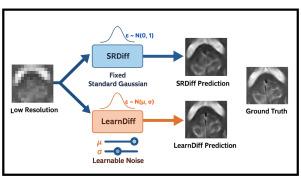LearnDiff: MRI image super-resolution using a diffusion model with learnable noise
IF 4.9
2区 医学
Q1 ENGINEERING, BIOMEDICAL
Computerized Medical Imaging and Graphics
Pub Date : 2025-09-01
DOI:10.1016/j.compmedimag.2025.102641
引用次数: 0
Abstract
MRI images with a superior spatial resolution may facilitate an accurate and faster diagnosis. We present LearnDiff, a diffusion probabilistic model with learnable noise for the super-resolution of MRI images. Unlike the standard diffusion models that rely on a fixed, standard normal distribution, LearnDiff utilizes a learnable Gaussian distribution in the diffusion bottleneck, enabling both forward and reverse processes to adapt dynamically. This flexibility addresses a critical limitation.
A standard normal distribution for noise may not be adequate in the context of MRI super-resolution using a residual approach. By allowing the noise distribution to be learnable, our model achieves SOTA performance on publicly available MRI images, showing a 3.8% improvement in PSNR compared to previous SOTA methods, significantly outperforming traditional diffusion models. Across multiple MRI datasets, our approach yields superior image quality and enhanced quantitative metrics, highlighting its effectiveness in capturing finer image details and achieving more accurate super-resolution. Link to the codebase.

LearnDiff:使用具有可学习噪声的扩散模型的MRI图像超分辨率
具有优越空间分辨率的MRI图像可以促进准确和快速的诊断。我们提出了LearnDiff,一个具有可学习噪声的扩散概率模型,用于MRI图像的超分辨率。与依赖固定的标准正态分布的标准扩散模型不同,LearnDiff在扩散瓶颈中利用可学习的高斯分布,使正向和反向过程都能动态适应。这种灵活性解决了一个关键的限制。在使用残差方法的MRI超分辨率背景下,噪声的标准正态分布可能不足够。通过允许噪声分布是可学习的,我们的模型在公开可用的MRI图像上实现了SOTA性能,与以前的SOTA方法相比,PSNR提高了3.8%,显著优于传统的扩散模型。在多个MRI数据集中,我们的方法产生了卓越的图像质量和增强的定量指标,突出了其在捕获更精细的图像细节和实现更准确的超分辨率方面的有效性。链接到代码库。
本文章由计算机程序翻译,如有差异,请以英文原文为准。
求助全文
约1分钟内获得全文
求助全文
来源期刊
CiteScore
10.70
自引率
3.50%
发文量
71
审稿时长
26 days
期刊介绍:
The purpose of the journal Computerized Medical Imaging and Graphics is to act as a source for the exchange of research results concerning algorithmic advances, development, and application of digital imaging in disease detection, diagnosis, intervention, prevention, precision medicine, and population health. Included in the journal will be articles on novel computerized imaging or visualization techniques, including artificial intelligence and machine learning, augmented reality for surgical planning and guidance, big biomedical data visualization, computer-aided diagnosis, computerized-robotic surgery, image-guided therapy, imaging scanning and reconstruction, mobile and tele-imaging, radiomics, and imaging integration and modeling with other information relevant to digital health. The types of biomedical imaging include: magnetic resonance, computed tomography, ultrasound, nuclear medicine, X-ray, microwave, optical and multi-photon microscopy, video and sensory imaging, and the convergence of biomedical images with other non-imaging datasets.

 求助内容:
求助内容: 应助结果提醒方式:
应助结果提醒方式:


